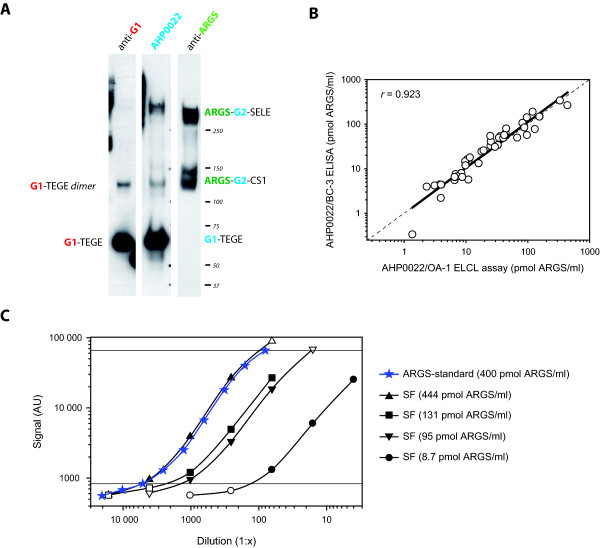Figure 2.
Specificity and technical performance of the aggrecan capture OA-1 ARGS ELCL assay. (a) 2.4 μg of ADAMTS-4-digested and deglycosylated human aggrecan was separated on a 3 to 8% Tris-acetate gel, transferred and probed with anti-G1, anti-aggrecan (AHP0022), or anti-ARGS (OA-1). Protein standard molecular weights and aggrecan fragments detected are indicated. Epitopes recognized by the antibodies are written in color: red, anti-G1; blue, anti-aggrecan (AHP0022); green, anti-ARGS. Aggrecan domains and amino acid sequences: G1 and G2, globular domains 1 and 2; CS1 and CS2, chondroitin sulfate-rich domains 1 and 2; TEGE and ARGS: C- and N-terminal amino acid sequences at the aggrecanase cleavage site within the interglobular domain; SELE, C-terminal amino acid sequence of aggrecanase cleavage within the CS2 [1]. (b) ARGS concentration measured with the OA-1 ARGS ELCL assay and the BC-3 ARGS ELISA [35] in 43 individual SFs with a regression line, dashed line of equality, and Pearson's correlation coefficient (r). (c) Dilution curves of ARGS-aggrecan standard and four synovial fluids (SFs) analyzed in the OA-1 ARGS ELCL assay. Sample concentrations of ARGS-aggrecan at different dilutions were calculated from the standard curve (four-parameter logistic). Dilutions falling within the range of detection of the standard curve (solid symbols within horizontal lines) were used for linearity of dilution calculations (Table 2), with mean values presented in the legend.

